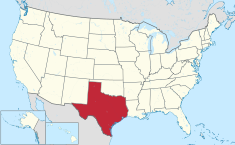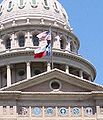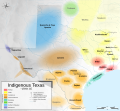Portal:Texas
The Texas Portal
Texas (/ˈtɛksəs/ TEK-səss, locally also /ˈtɛksɪz/ TEK-siz; Spanish: Texas or Tejas, pronounced [ˈtexas]) is the most populous state in the South Central region of the United States. It borders Louisiana to the east, Arkansas to the northeast, Oklahoma to the north, New Mexico to the west, and the Mexican states of Chihuahua, Coahuila, Nuevo León, and Tamaulipas to the south and southwest. Texas has a coastline on the Gulf of Mexico to the southeast. Covering 268,596 square miles (695,660 km2), and with over 30 million residents as of 2023, it is the second-largest U.S. state by both area and population. Texas is nicknamed the Lone Star State for its former status as an independent republic. The Lone Star can be found on the Texas state flag and the Texas state seal. Spain was the first European country to claim and control the area of Texas. Following a short-lived colony controlled by France, Mexico controlled the territory until 1836 when Texas won its independence, becoming the Republic of Texas. In 1845, Texas joined the United States as the 28th state. The state's annexation set off a chain of events that led to the Mexican–American War in 1846. Following victory by the United States, Texas remained a slave state until the American Civil War, when it declared its secession from the Union in early 1861 before officially joining the Confederate States of America on March 2. After the Civil War and the restoration of its representation in the federal government, Texas entered a long period of economic stagnation. Historically, four major industries shaped the Texas economy prior to World War II: cattle and bison, cotton, timber, and oil. Before and after the Civil War, the cattle industry—which Texas came to dominate—was a major economic driver and created the traditional image of the Texas cowboy. In the later 19th century, cotton and lumber grew to be major industries as the cattle industry became less lucrative. Ultimately, the discovery of major petroleum deposits (Spindletop in particular) initiated an economic boom that became the driving force behind the economy for much of the 20th century. Texas developed a diversified economy and high tech industry during the mid-20th century. , it has the most Fortune 500 company headquarters (53) in the United States. With a growing base of industry, the state leads in many industries, including tourism, agriculture, petrochemicals, energy, computers and electronics, aerospace, and biomedical sciences. Texas has led the U.S. in state export revenue since 2002 and has the second-highest gross state product. (Full article...) Selected article -The 2009 Dickies 500 was the 34th stock car race of the 2009 NASCAR Sprint Cup Series and the eighth in the ten-race season-ending Chase for the Sprint Cup. It was held on November 8, 2009 at Texas Motor Speedway, in Fort Worth, Texas, before a crowd of 167,000. Kurt Busch of the Penske Racing team won the 334-lap race starting from third position. Denny Hamlin of Joe Gibbs Racing finished second and Roush Fenway Racing's Matt Kenseth was third. Going into the event, Jimmie Johnson was leading his Hendrick Motorsports teammate Mark Martin in the Drivers' Championship by 184 points. Jeff Gordon won the pole position with the quickest recorded lap time in the qualifying session, although he was almost immediately passed by Kasey Kahne at the start of the race. Many Chase for the Sprint Cup participants, including Johnson and Carl Edwards encountered problems during the race. Kyle Busch was leading the race with three laps remaining but ran out of fuel, giving the lead, and the victory, to Kurt Busch. There were a total of eight cautions during the race and thirteen lead changes among four different drivers during the course of the race. (Full article...)Selected biography -Sandra Day O'Connor (March 26, 1930 – December 1, 2023) was an American attorney, politician, and jurist who served as an associate justice of the Supreme Court of the United States from 1981 to 2006. Nominated by President Ronald Reagan, O'Connor was the first woman to serve as a U.S. Supreme Court justice. A moderate conservative, she was considered a swing vote. Before O'Connor's tenure on the Court, she was an Arizona state judge and earlier an elected legislator in Arizona, serving as the first female majority leader of a state senate as the Republican leader in the Arizona Senate. Upon her nomination to the Court, O'Connor was confirmed unanimously by the United States Senate. O'Connor usually sided with the Court's conservative bloc but on occasion sided with the Court's liberal members. She often wrote concurring opinions that sought to limit the reach of the majority holding. Her majority opinions in landmark cases include Grutter v. Bollinger and Hamdi v. Rumsfeld. In 2000, she wrote in part the per curiam majority opinion in Bush v. Gore and in 1992 was one of three co-authors of the lead opinion in Planned Parenthood v. Casey that preserved legal access to abortion in the United States. On July 1, 2005, O'Connor announced her retirement, effective upon the confirmation of a successor. At the time of her death, O'Connor was the last living member of the Burger Court. Samuel Alito was nominated to take her seat in October 2005, and joined the Supreme Court on January 31, 2006. (Full article...)Texas news
Wikinews Texas portal
ListsState symbols
Texas topicsSelected imageCities - McAllen is a city in the U.S. state of Texas and the most populous city in Hidalgo County. It is located at the southern tip of the state in the Rio Grande Valley, on the Mexico–United States border. The city limits extend south to the Rio Grande, across from the Mexican city of Reynosa. McAllen is about 70 mi (110 km) west of the Gulf of Mexico. As of the 2020 census, McAllen's population was 142,210, making it the 23rd-most populous city in Texas. It is the fifth-most populous metropolitan area (McAllen–Edinburg–Mission) in the state of Texas, and the binational Reynosa–McAllen metropolitan area counts a population of more than 1.5 million. From its settlement in 1904, the area around McAllen was largely rural and agricultural in character, but the latter half of the 20th century had steady growth, which has continued in the 21st century in the metropolitan area. The introduction of the maquiladora economy and the North American Free Trade Association led to an increase in cross-border trading with Mexico. (Full article...)General imagesThe following are images from various Texas-related articles on Wikipedia.
CategoriesSelect [►] to view subcategories
Related pages
Attractions
 Things you can doAssociated WikimediaThe following Wikimedia Foundation sister projects provide more on this subject:
SourcesMore portals | ||||||||||||||||||||||||||||||||||||||||




































































